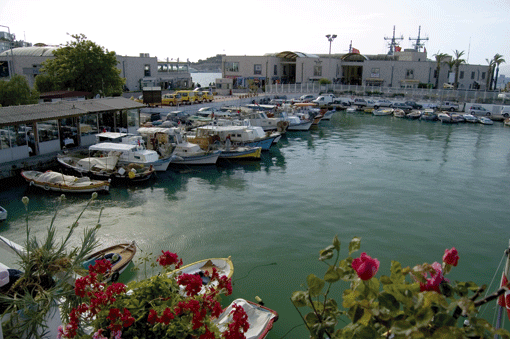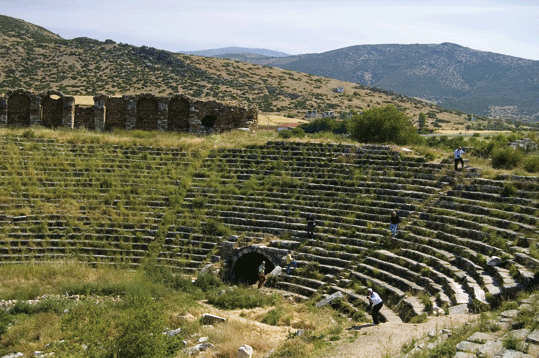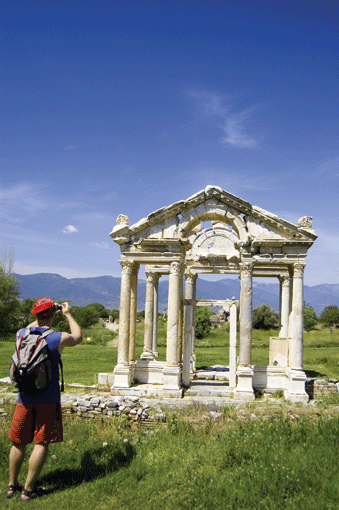
Travel
Kusadasi, Turkey’s
Beau monde Ambience

Kusadasi is a port city and former fishing village set on Turkey’s south Aegean coast.
It is an area of rolling hills and fertile valleys dotted with pine and cypress trees, olive groves and orchards.
By: Veronica Maria Garbutt
Some three centuries ago the Roman historian Herodotus observed that the region has the world’s best climate and summer breezes temper the fierce heat. The coast is indeed stunning, indented with countless bays and inlets. And no other part of the country can match this area for sheer concentration of ancient cities.
Thirty years ago when Kusadasi was discovered by the Mediterranean yachting fraternity it was a sleepy community of fishermen and farmers. The town–whose name means Bird Island–had only an un-metalled road running through it. Today however, the large harbour receives half a dozen cruise ships daily in summer. And the opening of the state of the art Setur Marina has drawn much traffic away from established maritime centres such as Bodrum and Marmaris.
A golden sandy beach, water-sports, stately caravanserai, Turkish baths, shopping in exotic bazaars and day trips to the Greek island of Samos draws plenty of visitors in the season. An army of tourists follow in the footsteps of the ancient Greeks and Romans drawn by the beauty of the surroundings encouraged by the flowering of such civilizations. Indeed they were at the forefront in the emergence of philosophy, the arts and sciences. The ensemble of ruins in the area spans several eras, most notably at Ephesus, Priene, Miletus and Didyma. Afrodsias, Hierapolis and Pamukkale are a couple of hours away by road.
Kusadisi’s history can be traced back to around 3000 BCE to the arrival of the Lelegians and Carians who spread westward from mild climate and fertile land. Later Greeks arrived from the islands and the two cultures merged to produce scholars and philosophers of note. In 945 BC the Persians arrived but by 2000 BCE the area was ruled by the Romans, the port of Ephesus dried up, Kusandasi became a significant trade centre known as Ania. By the 15th century Genoese and Venetian merchants who dominated the area gave the city the Italian name of Scala Nuova.
In 1413 the Ottomans under Sultan Mehmet Celebi laid claim to the city. Kusadasi was given a new look under Okuz Mehmet Pasa, a grand vizier under Ahmet I and Osman II. He built several mosques and a caravanserai and rebuilt the Byzantine coastal fortress to guard against seaborne attacks. After World War I Kusadasi was invaded by the Greeks in 1919 but after a struggle became part of the Turkish Republic in 1922. When Greeks and Turks exchanged populations, most Greeks moved west across the Aegean.
The heartbeat of Kusadasi is in the streets around the Karavanserai where the Ataturk Bulvari meets Liman Kadessi opposite the harbour. The main shopping street, Barberos Hayrettu Kadessi, is pedestrianised and leads eastward to the old market. Turn left at the post office to wander in the atmospheric narrow streets of the old city called Kale lined with restaurants and shops with vendors calling out their wares. The Okuz Mehmet Pasa Karavanserai–now a hotel–is a useful landmark in this city which has 20 clearly defined centres.
A Ladies Beach lies some 3 km southwest of town and has a cluster of resort hotels. But probably the best choice is Tusan beach, 5 km from the north side of town on the road to Selauk. It is much less crowded. Budget accommodation can be found in the town centre but the fancier 4 and 5 star hotels are dotted along the coastline at both ends of the town. Dolmus minibuses run regularly along the shore road into and out of town as well as north to Pygale Beach and south to the Ladies Beach.
Watersports fans might head for Grand Blue Sky, a resort which rents jet skis, waterskis and sea kayaks. At Keryn you can also try out parasailing, banana boating and the rizo (a floating trampoline). And if diving is your thing check out Aquaventure Dive Centre which offers instruction in addition to reef, cave and boat dives. Just over a kilometre offshore Dilek National Park is a mountainous nature reserve with quite isolated beaches. A good spot for picnics, it is covered with shady pine trees and opens at 8.00 am, closing at 18.30 pm daily.
Not far from Kusadasi lies Selcuk, a modern town with a lively market said to be the most colourful in the region. It is home to the Ephesus Museum, a repository of artefacts from fine jewellery to glass vessels and cooking pots. Some nine kilometers east, lie Sirince, a formerly Greek hill village surrounded by peach and apple orchards. This idyllic collection of stone and stucco houses with red-tiles roofs was the setting of Dido Sotiriou’s novel Farewell to Anatolia. Solirion documented the Greek Asia Minor experience and its post 1922 developments and it is interesting to note that the descendents of Muslims from Thessalonika in Greece still work the orchards today. Lace-making and carpet weaving thrive in the area too.
No self-respecting visitor stays in Kusadasi without allotting a day to visit Ephesus, the largest and best preserved city of the Mediterranean region. Best time to visit is early morning or late afternoon and you can easily get there by dolmus, a distance of some 16 km. At the end of the 1st Century BCE Ephesus had a population of roughly one third-of-a-million and later it was the capital of the Roman province of Asia. This Graeco-Roman site is special appeal lies in the completeness and the main points of interest are the Great Theatre, Library of Celsus, Slope House (a three storey Roman house), the Gymnasium of Vedine, the Stadium, Odeum (small theatre) and the harbour baths. Unmissable!
The ancient sites of Miletus, Priene and Didyna are the best preserved Ionian settlements in Anatolia. Best bet is to rent a car, but if you don’t mind doing a lot of walking you can get there by bus via Soke. The sea trading city of Miletus gave the world the alphabet and is notable for its great Roman Theatre and Baths of Fuasling.
Standing on wooden hills above the scenic Manderes River Priene was the first city built on a grid plan and was later occupied by the Romans who left it unchanged. Here the best preserved ruins are the theatre, Terion (Senate House) and several private houses. Didyma is connected to Milatus by a marble road. It is noted for its phalanx of Corinthian columns and opposite lies, the Asik restaurant, a good place to refresh yourself and recharge those–by now–tired batteries.
Some 150 km east of Kusadasi, lies the sight illustrating travel posters of Turkey…the pools of Pamukkale. These pools of sparkling white crystal spill down a mountainside with a network of terraces, hot springs and stalactite rock formations. The name Pamukkale means ‘Cotton Castle’ and it has taken over 14,000 years for this World Heritage Site to develop. The ancient city atop this marvel, Hierapolis, dates from Roman times. This is the place to bathe in the 96 degrees C waters of the Antique Pool amid out-merged sections of the original marble columns. Quite a novelty, really, and I found the experience most therapeutic!
Yet another remarkable archaeological site, Afrodisias, lies some 150 km east of Ephesus. Come in May or June and the place teems with bright red poppies. Here the acropolis date back to 5000 BC and the focal point is the spectacular stadium where athletics rivalling the Olympic Games were held. While on site be sure to check out the ruins of a grand house complete with Ionic and Corinthian pillars, the elaborate monumental gateway or Tetrapylon, the Hadrianic Baths, southern agora and the Portico of Tiberius. Afrodisias today is associated with the work of American Professor Kenan T. Erin who put the site back on the map in the 1960s.
If you have more time to spare don’t miss a day trip to Izmir, Turkey’s third largest city and main Mediterranean port. The highlights of Smyrna (as the city was known in early Greek times) are the agora and acropolis set on Kadifekale hill. The city today has regained its beau monde ambience and the streets of Alsanak and Kordom Promenade offer cafes, restaurants on a par with Europe’s finest. Shopping too is a highlight with jewellery, leatherwear and shoes the best buys in the bazaar quarter. And in the Ethnography Museum you will even find a reconstructed Ottoman chemist’s shop. Happy trip!